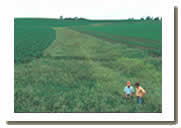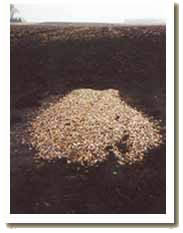Minnesota River Basin - Best Management Practices
Best Management PracticesMany landowners across the watershed are working to help reduce the amount of sediment and nutrients entering the waterways. There are many approaches that landowners can take. The overarching concept for all of these techniques is to slow the flow of water and increase its residence time on the landscape. Holding the water on the landscape longer has many benefits. It reduces the "flashy" flow pattern and the water's erosive power by reducing flow volume and velocity during floods. The sediment and attached phosphorus is able to settle out rather than continuing downstream. Increasing residence time also enables aquatic plants and organisms to consume some of the dissolved contaminants.Here are some of the techniques, called best management practices. |
||
 |
Buffer strips can be used to line cultivated fields, the banks of open ditches and streams, or border wetlands. Buffer zones are strips of grass or other naturally occurring plants, whose root systems hold the soil together to prevent erosion while the stalks trap sediment. | |
 |
Grassed waterways are strips of uncultivated grass running through a cultivated field. They are natural or constructed channels intended to transport water without erosion. | |
 |
A rock inlet is a structure that provides a filter on top of a tile intake. As opposed to the tile line emerging at the surface, it is buried beneath a pile of gravel. Sediment caught up in overland flow makes its way across the field and encounters the rock inlet. Water is able to percolate down through the gravel and into the tile line, but soil, phosphorus, and other debris gets caught up. | |
 |
A closed intake fits over the mouth of a tile line intake located in the middle of a cultivated field and traps sediment. The orange column has holes big enough to allow water to pass through at a sufficient rate during a flooding event, but it does not allow a pit to develop that soil can pour down into. It also has a greater ability to retain debris (you can see that the bottom holes are clogged) than the orange basket mounted on the open intake. | |
 |
The Farmable Wetlands Project has been created to provide an incentive to farmers to re-establish wetlands in the watershed. Wetlands increase the residence time needed to naturally clean contaminated water. Funds are available through the Conservation Reserve Program (CRP) for enrolling wetlands and land along ditches.
|
|
|
Other techniques to reduce sediment and nutrients running into the waterways include Close Pattern Tiling, Nutrient Management, and Conservation Tillage, Gully control structures, Terraces, among many others. Conservation Tillage – University of Minnesota Extension Service
Soil Nutrient Management – University of Minnesota Extension Service
Natural Resource Conservation Service Conservation Programs |
||
